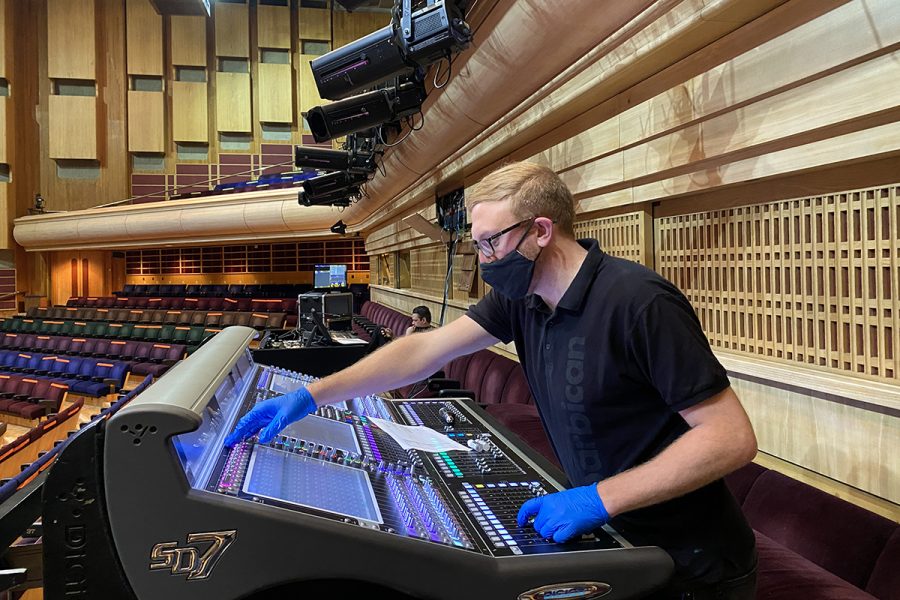Presenting socially distanced and reduced-audience experiences, livestreamed directly into the comfort of your home, London’s Barbican – considered one of the UK’s go-to live performances spaces – has been able to reach a new global audience during and post-lockdown. At the heart of the sonic delivery of each show is a host of DiGiCo solutions.
During the lockdown, Barbican Head of Music, Huw Humphreys, asked Technical Manager, Mark Bloxsidge and Technical Supervisors Jason Kew (Lighting), Martin Shaw (AV) and Tom Shipman (Sound) to design a way of working and a wish list of equipment to fulfil the requirements for livestreamed concerts. “DiGiCo was the immediate choice for the audio,” Shipman said, praising Humphreys’ vision and determination for a high-quality product against all odds.
The Barbican’s TV Gallery – known as BTV – is the heart of their livestreaming operation and features a recently purchased SD9 console and SD-Mini Rack to add to the SD7, SD10 and SD9 consoles and SD Racks previously supplied and installed at the venue by Autograph.
The new purchase allowed the Barbican technical team to network all their consoles and racks optically to facilitate the audio workflow needed for these broadcasts. “Owning four DiGiCo consoles is terrific,” Bloxsidge enthused. “While you wouldn’t think of DiGiCo first when you’re considering studio work, they’ve proved to be excellent and with the advantage that our sound crew know how to use them already.”
The Barbican’s SD7 and one of their SD9s take care of FOH and monitors respectively in the Concert Hall, while the SD10 shares the same inputs for a broadcast remix. This remix is then sent on to the new SD9 in BTV where additional audience mics and any pre-recorded content are blended with the music, while adding any lip-sync delay, dynamics and limiting required for the livestream encoders.
Room 304, a former BBC sound mixing studio backstage at the Barbican, has been recently refurbished by Munro Acoustics and is now home to the Barbican’s DiGiCo SD10, outboard FX and Dynaudio monitors. Barbican Sound Technician, Jonny Teanby regularly mixes the broadcast audio of each livestream from here. “Workflow-wise, because I’m somewhere between doing live and studio, it’s nice to have a familiar tool in DiGiCo to use. The SD10 is ideal for this because I can see all the channels easily,” Teanby explained.
“We’ve also experimented with moving the SD9 monitor console backstage and doing the monitor mix remotely,” Bloxsidge continued. “During soundcheck the engineer will be on stage with an iPad setting up foldback for the artists but will then move back out of the way so as not to appear on TV.”
The monitor engineer watches the action over a bank of screens and the Barbican provides multi-camera viewpoints, so the engineers feel like they’re in the Hall.
“We have our standard show relay wide shot, a conductor camera, which is a reverse look at the stage from an elevated position,” Shipman explained. “There’s the TX feed from BTV and a dedicated PTZ, which is operated by the monitor engineer as a pair of eyes on stage as a normal monitor position would be and there’s the DiGiCo overview screen.” The Barbican also provides engineers with DiGiGrid MGB for increased flexibility. “Being able to get 128 channels in and out of it is incredible, and just over a bit of cat5 and a gigabit ethernet port on your computer is fantastic. Now that it’s a way to run Waves, it’s an ideal choice for us, not just for multitrack recording, but for external effects,” he commented.
Among the big-name acts on the bill, Paul Weller took to the stage for his first live gig in two years, with the backing of the BBC Symphony Orchestra in a performance curated and arranged by Jules Buckley as part of the Live from the Barbican livestream series. “There were only two active DiGiCo consoles on that particular show,” Bloxsidge, said, referencing an SD12, Sound Engineer, Phil Wright brought in and one of the venue’s in-house SD9s, situated in the TV gallery for a presentation mix. “Phil brought in a couple of SD Racks. We networked them together, the inputs were then split via MADI with the BBC’s OB truck and they sent a broadcast mix back to us for our livestream.”
Faced with livestreams or nothing in lockdown, Bloxsidge recalled the steep learning curve of working out how to do live TV. “We engaged the services of TV professionals including directors and script supervisors alongside our in-house staff to make sure it was the best standard possible,” he explained, praising the Barbican’s raft of in-house camera operators and the sound mixers.
“We’ve always facilitated rentals to external promoters and put our staff in positions where they can be creative as often as they can, certainly for our own productions. If a performing artist has their own engineer, we also facilitate that.”
Unlike many other venues, the Barbican curates and promotes its own shows. “The Live from the Barbican livestream series has been a fantastic opportunity to give our staff as many creative roles within the broadcast as we can, rather than just working for visiting creatives. We find ourselves reaching audiences who may have never engaged with the venue before.”
This article originally appeared in issue #266 of TPi, which you can read here.


